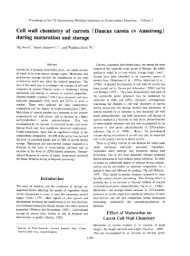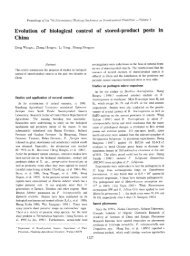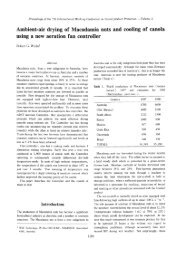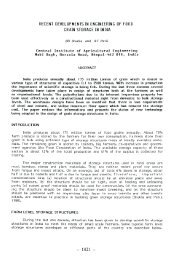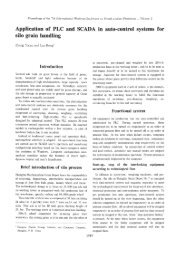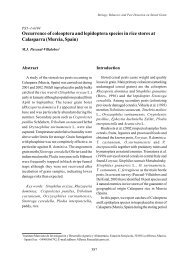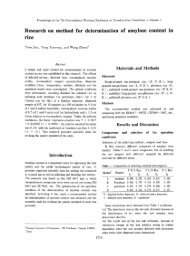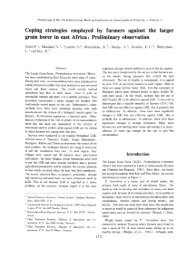72-87 - SPIRU Index Page
72-87 - SPIRU Index Page
72-87 - SPIRU Index Page
You also want an ePaper? Increase the reach of your titles
YUMPU automatically turns print PDFs into web optimized ePapers that Google loves.
Proceedmgs of the 7th Iniernatumal Workmg Cmlference on Stored-product Protectvm - Volume 1<br />
concentrate on Uscana larwphaga Steffan (Hymenoptera<br />
Tnchogrammatidae ) Egg parasitoids have the advantage<br />
that they kill their host already before It has done any<br />
damage (contrary to larval parasrtoids)<br />
U larwphaga ISindigenous to West Africa In the field<br />
and m storage It IS responsible for a substantial amount of<br />
mortality of C maculaius (Lammers & Van HUlS, 1989,<br />
Sagma, 1994) Its hfe-lustory, functional response and host<br />
location have been mvestigated m the laboratory (Van<br />
Alebeek, 1996) We are mvestigatmg possibilmes to<br />
mcrease the Impact of U larwphaga on C maculaius<br />
populations, usmg a 'conservation strategy' of biological<br />
control Tlus strategy ISaimed at conservmg the populations<br />
of natural enemies that are already present m the system<br />
(rather than mtroducmg exotic natural enemies, or<br />
producmg and regularly releasmg large numbers of natural<br />
enemies) (Arbogast, 1984, Van HUlS, 1991, Van HUISet<br />
al , 1991, Waterhouse, 1992) Conservation biological<br />
control IS especially mterestmg for resource-poor farmers<br />
(Waterhouse, 1992) In this particular case, prormsing<br />
options are (Van Alebeek, 1996) ( 1) marupulatmg the<br />
storage environment, such that conditions for U<br />
larwphaga are optirruzed, (2) offenng food to the adult<br />
parasitoids to enhance their longevity and fecundity, (3)<br />
moculatmg the cowpea storage With Uscana from locally<br />
available resources, and (4) addmg plants or plant extracts<br />
to the stored beans which kill or repel the bruchids but do<br />
not harm the natural enenues These strategies can of<br />
course be combmed, for example, plant extracts (option 4)<br />
and Uscana (option 3) could be added at the same time<br />
The four options, and the possible role of simulation<br />
modellmg, are discussed below<br />
(1) Manipulation of the storage environment<br />
Temperature IS one of the mam driving forces of msect<br />
development and population dynanucs Insect species differ<br />
m theIr temperature responses It IS therefore poSSiblethat<br />
at certam temperature regImes, a natural enemy perfonns<br />
relatively better, and ItS host worse, than at other<br />
temperatures A SImulationmodel, based on experImentally<br />
detennmed temperature-dependent development rates of<br />
both host and parasltOld, could help establIsh whether such a<br />
temperature regime eXIsts If It eXiSts, It would be<br />
worthwhIle to mvestlgate whether such temperatures can be<br />
achieved by SImple changes m the placement and<br />
construction of tradItional grananes (Van HUIS et al ,<br />
1994) For example, a granary can be placed m the shadow<br />
or m the sunlIght (Van HUISet al , 1994), or a roof which<br />
allows for mcreased ventilation m the granary could be<br />
constructed (J Mumford, personal commurucatlon, see also<br />
Hames, 1984) Meanwhile, Van HUISet al (1994) have<br />
ShOWllthat, when U lanophaga IS offered an excess of<br />
eggs, Its rm value at 35"C ISdouble the value at 20'C , whIle<br />
the rm of C nmculatus remams constant and IS always<br />
74<br />
below that of U lariophaqa However, when the<br />
availabihty of bruchid eggs IS hmited. the I'm value of U<br />
larwphaga may be lower<br />
(2) Offenng food to parasrtoids Access to honey<br />
mcreases the fecundity of Uscana larwphaga by three<br />
times, and ItS longevity by five times, as compared to<br />
parasitoids that are starved (Van HUISet al , 1991) If such<br />
a result could be achieved m storage, It would probably exert<br />
mfluence on the bruchid population (see Wakers, 1998,<br />
Wakers, m prep) Whether enhanced pest control as a<br />
result of additional food ISto be expected, and how much the<br />
longevity and fecundity should be mcreased m order to<br />
obtam an adequate effect, can be assessed usmg a computer<br />
simulation model If simulations mdicate that feedmg the<br />
parasitoids has a sufficient negative effect on the bruchid<br />
populations, 'field' expenments could be set up in order to<br />
test this prediction However, practically feasible ways of<br />
adrrurustenng food to the parasitoids should be found<br />
(3) Inoculating the cowpea storage With Uscana There<br />
are many bruchid species which infest pulses of legummous<br />
trees (e g Woegan, 1995) Those bruclnds are not<br />
associated With cowpea, and many have only a few<br />
generations per year The same bruchids are also hosts to<br />
Uscana spp , which in turn are also capable of attackmg the<br />
bruchids of cowpea (A Van HUlS, C Schutte & S Sagnia,<br />
unpublished results) These resources of natural enemies<br />
could be used m bruchid control by adding pulses of these<br />
trees to cowpea stocks, at a time when the bruchid<br />
population IS most vulnerable to an mcreased density of<br />
parasitoids Farmers could even set up small temporary<br />
reanngs of natural enemies, based on this leguminous plant<br />
matenal, and release them mto their granary Legummous<br />
trees are relatively abundant m the dry Sahel zone, and<br />
farmers are fanuhar With these trees because they use the<br />
leaves for medical purposes, flavourmg food, and as food<br />
protectants, and the pulses are used as arumal feed (D K<br />
Kossou, personal commurucatlon) Reanng of parasltOlds at<br />
VIllage level IS feasible, as demonstrated by farmers m<br />
MeXICOwho rear parasltOlds for the control of the coffee<br />
berry borer (Galvez, 1992) Reanng of parasltOlds on<br />
bruchlds m pulses from legummous trees IS currently under<br />
mvestlgatlon m Togo (I A GlItho & S F Bolevane,<br />
personal commumcatlon) Computer SImulations, together<br />
With data obtamed from population-dynamics expenments,<br />
could help decide at which time m the storage season<br />
moculatlons With parasltolds are most lIkely to be effective,<br />
and how many parasltOlds should be used These predIctions<br />
can then be tested m expenmental grananes<br />
(4) Dned leaves and other parts of many plants are used<br />
m traditional control methods Some of these plant products<br />
may not be hannful to the parasltOldsof bruchlds, dependmg<br />
on the properties of the plant speCIeS The parasltOld<br />
population that IS left behmd after treatment With these




